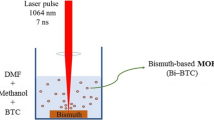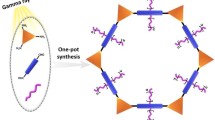Abstract
In the present manuscript, we report the synthesis of Zn-BDC MOF using a modified solvothermal method. As synthesized Zn-BDC MOF is exposed to gamma (γ) radiation doses, the dose exposure is between 0 and 50 kGy. It is observed that γ radiations are probably absorbed by zinc metal, and due to adsorption of γ the structure of the MOF is not changing, which suggests that the MOF structure regains its structural stability at higher γ radiation doses. Further, for the first time, we reported that the stability of Zn-BDC MOF is up to 35 kGy, it has been observed that, there is an irradiation effect on the higher porosity of MOF. The present findings strongly suggest the radiation-sensitive nature of Zn-BDC MOF.








Similar content being viewed by others
References
Cook TR, Zheng Y-R, Stang PJ (2012) Metal–organic frameworks and self-assembled supramolecular coordination complexes: comparing and contrasting the design, synthesis, and functionality of metal–organic materials. Chem Rev 113(1):734–777
Safdar Ali R, Meng H, Li Z (2021) Zinc-based metal-organic frameworks in drug delivery, cell imaging, and sensing. Molecules 27(1):100. https://doi.org/10.3390/molecules27010100
Farha OK et al (2012) Metal–organic framework materials with ultrahigh surface areas: is the sky the limit? J Am Chem Soc 134(36):15016–15021
Fang Z et al (2014) Structural complexity in metal–organic frameworks: Simultaneous modification of open metal sites and hierarchical porosity by systematic doping with defective linkers. J Am Chem Soc 136(27):9627–9636
Zheng F et al (2019) Advanced electrocatalysts based on metal–organic frameworks. ACS Omega 5(6):2495–2502. https://doi.org/10.1021/acsomega.9b03295
Park KS et al (2006) Exceptional chemical and thermal stability of zeolitic imidazolate frameworks. Proc Natl Acad Sci 103(27):10186–10191
Senthil Raja D et al (2016) Synthesis of mixed ligand and pillared paddlewheel mofs using waste polyethylene terephthalate material as sustainable ligand source. Microporous Mesoporous Mater 231:186–191
Abdelkareem MA et al (2022) High-performance effective metal–organic frameworks for electrochemical applications. J Sci Adv Mater Devices 7(3):100465
Aamer I et al (2021) Synthesis, characterization and co2 adsorption studies of DABCO based pillared Zn-BDC and Co-BDC metal organic frameworks. Mater Res Express 8(7):075506. https://doi.org/10.1088/2053-1591/ac14ff
More MS et al (2023) Metal–organic framework-reduced graphene oxide (Zn-BDC@rGO) composite for selective discrimination among ammonia, carbon monoxide, and sulfur dioxide. Appl Phys A 129(12):828. https://doi.org/10.1007/s00339-023-07103-0
Qazvini OT, Babarao R, Telfer SG (2021) Selective capture of carbon dioxide from hydrocarbons using a metal-organic framework. Nat Commun 12(1):197. https://doi.org/10.1038/s41467-020-20489-2
Pettinari C, Tombesi A (2020) Metal–organic frameworks for carbon dioxide capture. MRS Energy Sustain 7(1):E35. https://doi.org/10.1557/mre.2020.30
Jiao L et al (2019) Metal–organic frameworks: structures and functional applications. Mater Today 27:43–68
Masoomi MY et al (2019) Mixed-metal mofs: unique opportunities in metal–organic framework (MOF) functionality and design. AngewandteChemie 131(43):15330–15347
Zhou G, Wang Y, Huang Z (2022) Structure and function tailored metal-organic frameworks for heterogeneous catalysis. Chem Catalysis 2(12):3304–3319
Kirlikovali KO et al (2022) Back to the basics: developing advanced metal–organic frameworks using fundamental chemistry concepts. ACS Nanoscience Au 3(1):37–45
Lu Z et al (2020) Node-accessible zirconium mofs. J Am Chem Soc 142(50):21110–21121
Wang Y et al (2021) NH2-uio-66 coated with two-dimensional covalent organic frameworks: high stability and photocatalytic activity. ACS Appl Mater Interfaces 13(25):29916–29925
Chen T et al (2022) In situ synthesis of MOF-74 family for high areal energy density of aqueous nickel–zinc batteries. Adv Mater 34(30):2201779
Cheng Y et al (2022) Advances in metal–organic framework-based membranes. Chem Soc Rev 51(19):8300–8350
Zou M, Dong M, Zhao T (2022) Advances in metal-organic frameworks MIL-101(CR). Int J Mol Sci 23(16):9396
Liu Z et al (2017) A battery-supercapacitor hybrid device composed of metallic zinc, a biodegradable ionic liquid electrolyte and graphite. J Solid State Electrochem 22(1):91–101
Samuel MS et al (2018) A GO-CS@MOF [zn(bdc)(dmf)] material for the adsorption of chromium(vi) ions from aqueous solution. Compos B Eng 152:116–125
Volkringer C et al (2016) Stability of metal–organic frameworks under Gamma irradiation. Chem Commun 52(84):12502–12505
Pu X et al (2021) Preparation and carbonization of metal organic framework Zn(BDC)(Ted)0.5 for enhancing moisture resistance and methane storage capacity. Ind Eng Chem Res 60(10):3809–3818
Rosales-Vázquez LD et al (2020) Structure of a luminescent MOF-2 derivative with a core of zn(ii)-terephthalate-isoquinoline and its application in sensing of xylenes. Crystals 10(5):344
Stock N, Biswas S (2011) Synthesis of metal-organic frameworks (mofs): routes to various MOF topologies, morphologies, and composites. Chem Rev 112(2):933–969
Dutta R, Rao MN, Kumar A (2019) Investigation of ionic liquid interaction with znbdc-metal organic framework through scanning EXAFS and inelastic neutron scattering. Sci Rep 9(1):147
de Assis SGF et al (2019) Design of new europium-doped luminescent mofs for UV radiation dosimetric sensing. J Solid State Chem 276:309–318
Fiaz M et al (2020) Synthesis of efficient TMS@MOF-5 catalysts for oxygen evolution reaction. Catal Lett 150(9):2648–2659
Trung LG et al (2023) Highly efficient degradation of reactive black KN-B dye by ultraviolet light responsive zif-8 photocatalysts with different morphologies. RSC Adv 13(9):5908–5924
Arabbaghi EK et al (2021) Zn-MOF: an efficient drug delivery platform for the encapsulation and releasing of Imatinib Mesylate. J Porous Mater 28(2):641–649
Isherwood LH et al (2021) Gamma radiation-induced oxidation, doping, and etching of two-dimensional MOS2 crystals. J Phys Chem C 125(7):4211–4222
Elsherbiny AS et al (2023) Efficiency and selectivity of cost-effective Zn-MOF for dye removal, kinetic and thermodynamic approach. Environ Sci Pollut Res
Ma C et al (2022) Effects of high gamma doses on the structural stability of metal–organic frameworks. Langmuir 38(29):8928–8933
Acknowledgements
The authors would also like to thank Fergusson College (Autonomous), Pune, and Savitribai Phule Pune University for their kind financial assistance and support throughout the experiments.
Author information
Authors and Affiliations
Corresponding authors
Additional information
Publisher's Note
Springer Nature remains neutral with regard to jurisdictional claims in published maps and institutional affiliations.
Rights and permissions
Springer Nature or its licensor (e.g. a society or other partner) holds exclusive rights to this article under a publishing agreement with the author(s) or other rightsholder(s); author self-archiving of the accepted manuscript version of this article is solely governed by the terms of such publishing agreement and applicable law.
About this article
Cite this article
Mane, S.N., Kolekar, S.K., Sapnar, K.B. et al. Gamma radiation induced modification in metal–organic framework: a case study. J Radioanal Nucl Chem (2024). https://doi.org/10.1007/s10967-024-09430-9
Received:
Accepted:
Published:
DOI: https://doi.org/10.1007/s10967-024-09430-9




